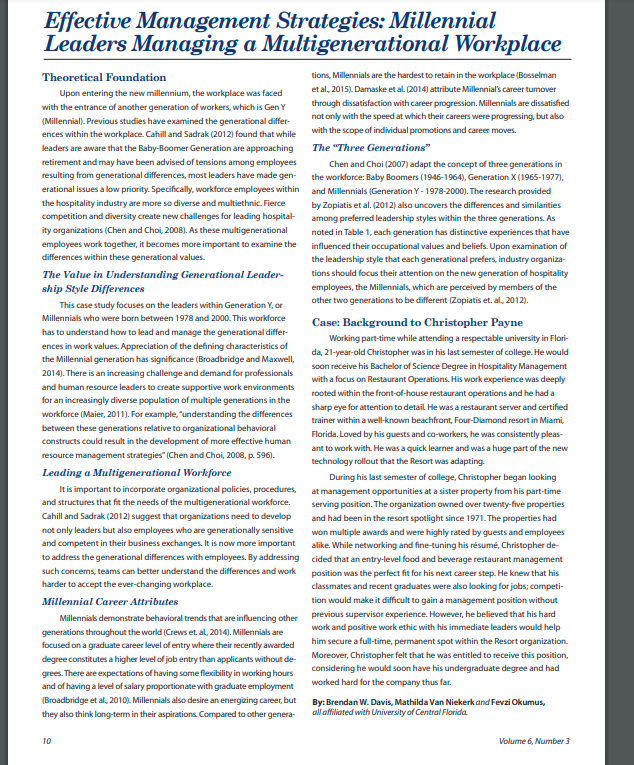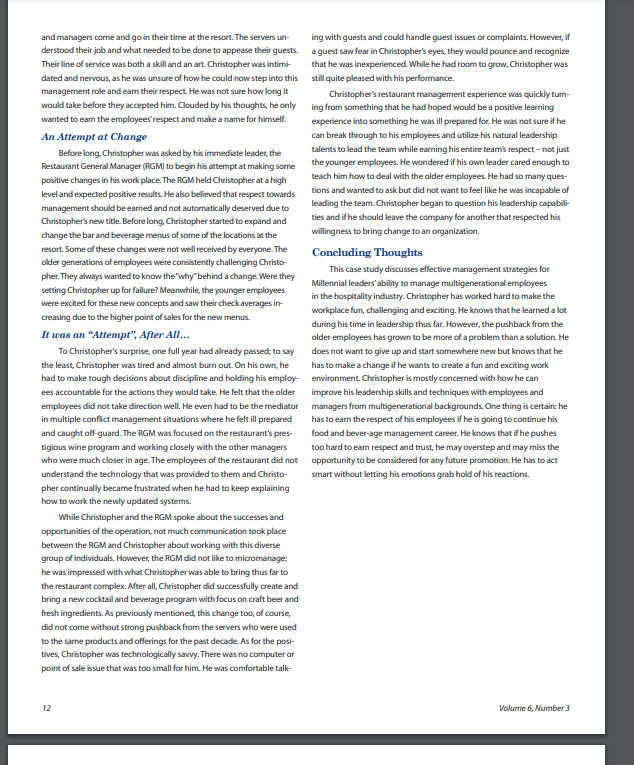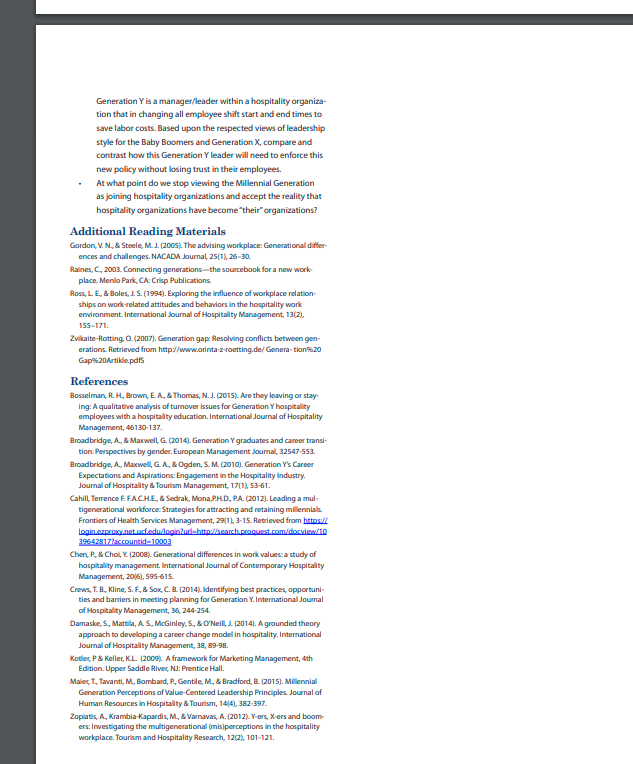Question
Read the associated case study 2. Reflect on the information covered in the assigned chapters for the unit. 3. Compose and submit a paper o




Read the associated case study 2. Reflect on the information covered in the assigned chapters for the unit. 3. Compose and submit a paper o Formatting: double-spaced, Arial font type, 12-point font size, 1 inch margins o Length: minimum three full pages; maximum five full pages o Content: thoroughly examine the workplace culture from the perspectives of the different generations represented in the case study discuss what Christopher should do to improve his relationship with his immediate leader, the RGM (who is Generation X) discuss strategies Christopher could use to positively influence the behaviors and attitudes of the older generation of employees Should Christopher use different leadership styles while leading his team? Or, should he use a mixture of leadership styles to breakthrough to his team? Identify which leadership styles should be used with which employee population(s) and why.
Effective Management Strategies: Millennial Leaders Managing a Multigenerational Workplace Theoretical Foundation Upon entering the new millennium, the workplace was faced with the entrance of another generation of workers, which is Gen Y (Millennial). Previous studies have examined the generational differences within the workplace. Cahill and Sadrak (2012) found that while leaders are aware that the Baby-Boomer Generation are approaching retirement and may have been advised of tensions among employees resulting from generational differences, most leaders have made generational issues a low priority. Specifically, workforce employees within the hospitality industry are more so diverse and multiethnic. Fierce competition and diversity create new challenges for leading hospitality organizations (Chen and Choi, 2008). As these multigenerational employees work together, it becomes more important to examine the differences within these generational values. The Value in Understanding Generational Leadership Style Differences This case study focuses on the leaders within Generation Y, or Millennials who were born between 1978 and 2000. This workforce has to understand how to lead and manage the generational differences in work values. Appreciation of the defining characteristics of the Millennial generation has significance (Broadbridge and Maxwell, 2014). There is an increasing challenge and demand for professionals and hurnan resource leaders to create supportive work environments for an increasingly diverse population of multiple generations in the workforce (Maier, 2011). For example, "understanding the differences between these generations relative to organizational behavioral constructs could result in the development of more effective human resource management strategies" (Chen and Choi, 2006, p. 596). Leading a Multigenerational Workforce It is important to incorporate organizational policies, procedures, and structures that fit the needs of the multigenerational workforce. Cahill and Sadrak (2012) suggest that organizations need to develop not only leaders but also employees who are generationally sensitive and competent in their business exchanges. It is now more important to address the generational differences with employees. By addressing such concems, teams can better understand the differences and work harder to accept the ever-changing workplace. Millennial Career Attributes Millennials demonstrate behavioral trends that are influencing other generations throughout the world (Crews et. al, 2014). Millennials are focused on a graduate career level of entry where their recently awarded degree constitutes a higher level of job entry than applicants without degrees. There are expectations of having some flexibility in working hours and of having a level of salary proportionate with graduate employment (Broadbridge et al., 2010). Millennials also desire an energizing career, but they also think long-term in their aspirations. Compared to other genera- tions, Millennials are the hardest to retain in the workplace (Bosselman et al_, 2015). Damaske et al. (2014) attribute Millennial's career tumover through dissatisfaction with career progression. Millennials are dissatisfied not only with the speed at which their careers were progressing, but also with the scope of individual promotions and career moves. The "Three Generations" Chen and Choi (2007) adapt the concept of three generations in the workforce: Baby Boomers (1946-1964), Generation X(1965-1977), and Millennials (Generation Y19782000 ). The research provided by Zopiatis et al. (2012) also uncovers the differences and similarities among preferred leadership styles within the three generations. As noted in Table 1, each generation has distinctive experiences that have influenced their occupational values and beliefs. Upon examination of the leadership style that each generational prefers, industry organizations should focus their attention on the new generation of hospitality employees, the Millennials, which are perceived by members of the other two generations to be different (Zopiatis et. al., 2012). Case: Background to Christopher Payne Working part-time while attending a respectable university in Florida, 21-year-old Christopher was in his last semester of college. He would soon receive his Bachelor of Science Degree in Hospitality Management with a focus on Restaurant Operations. His work experience was deeply rooted within the front-of-house restaurant operations and he had a sharp eye for attention to detail He was a restaurant server and certified trainer within a well-known beachfront, Four-Diamond resort in Miami, Florida. Loved by his guests and co-workers, he was consistently pleasant to work with. He was a quick learner and was a huge part of the new technology rollout that the Resort was adapting. During his last semester of college, Christopher began looking at management opportunities at a sister property from his part-time serving position. The organization owned over twenty-five properties and had been in the resort spotlight since 1971. The properties had won multiple awards and were highly rated by guests and employees alike. While networking and fine-tuning his rsum, Christopher decided that an entry-level food and beverage restaurant management position was the perfect fit for his next career step. He knew that his classmates and recent graduates were also looking for jobs; competition would make it difficult to gain a management position without previous supervisor experience. However, he believed that his hard work and positive work ethic with his immediate leaders would help him secure a full-time, permanent spot within the Resort organization. Moreover, Christopher felt that he was entitled to receive this position, considering he would soon have his undergraduate degree and had worked hard for the company thus far. By: Brendan W. Davis, Mathilda Van Niekerk and Fevzi Okumus, all affiliated with University of Central Florida. 10 Volume 6, Number 3 Generation Y is a manager/leader within a hospitality organization that in changing all employee shift start and end times to save labor costs. Based upon the respected views of leadership style for the Baby Boomers and Generation X, compare and contrast how this Generation Y leader will need to enforce this new policy without losing trust in their employees. - At what point do we stop viewing the Millennial Generation as joining hospitality organizations and accept the reality that hospitality organizations have become "their" organizations? Additional Reading Materials Gordon, V. N \& Steele, M. (2005). The advising workplace: Generational differences and challenges. NACADA Journal, 25(1), 26-30. Raines, C, 2003. Connecting generations-the sourcebook for a new workplace. Menlo Park, CA: Crisp Publications. Ross, L. E, \& Boles, J. S. (1994). Exploring the influence of workplace relationships on work-related attitudes and behawiors in the hospitality work emwronment. International Journal of Hospitality Management, 13(2), 155-171. Zvilaite-flotting, Q (2007). Generation gap. Resolving conflicts between generations. Fetrieved from http//Www.orinta-z-roetting.de/ Genera- tion\%620 Gap?a20Artille.pdfs References Bosseiman, R. H, Brown, E A, \& Thomas, N. J. (2015).A. Are they leaving or stay. ing: A qualitative analysis of turnover issues for Generation Y hospital ty employees with a hospitality education. International Journal of Hospitality Management, 45130-137. Broadbridge, A, \& Mawwelt, G. (2014). Generation Y graduates and career transition: Perspectives by gender. European Management Journal, 32547-553. Broadbridge, A, Maxwell, G. A, \& Ogden, S. M. (2010). Generation Y's Career Expectations and Aspirations. Engagement in the Hospitality Industry. Journal of Hospitalty \& Tourism Management, 17(1), 53-61. Cahilt, Terrence F. F.A.C.H.E, \& Sedrak, Mona,P.H.D, P.A. (2012). Leading a multigenerational workforce:Strategies for attracting and retaining millenniak. Frontiers of Health Services Management, 29/11, 3-15. Retrieved from https:/l 39642817 ?accountid=10003 Chen, P& Chol, X (2008), Generational differences in work values:a study of hospitality management. International Journal of Contemporary Hospitality Management, 20/6), 595-615. Crews, T. B, Kline, S. F, \& Sox, C. B. (2014) Identifying best practices, opportunities and barriers in meeting planning for Generation Y. International Journal of Hospital try Management, 36, 244-254. Damaske, S, Mattla, A S., McGinley, S, \& ONNeill, 1. (2014). A grounded theory approach to developing a career change model in hospitality. International Journal of Hospitality Management, 38, 89-98. Kotlec, P \& Keller, KL. (2009). A framework for Marketing Management, 4th Edition. Upper Saddle River, NJ: Prentice Hall. Maler, T, Tawanti, M, Bombard, P. Gentle, M, \& Bradford, B. (2015). Millennial Generation Perceptions of Value-Centered Leadership Princlples. Journal of Human Resources in Hospitalty \& Tourism, 14/4), 382-397. Zoplatis, A, Krambia-Kapardis, M, \& Varnavas, A. (2012). Y-ers, X-ers and boomers: Investigating the multigenerational (mis)perceptions in the hospitality workplace. Tourism and Hospitality Research, 12(2), 101-121. Generational matrix with views on leadership style Graduation... New Job, New Beginning After a few panel interviews, Christopher received a phone call that he had received a position within the food and beverage management department. Elated and excited, Christopher started his new position two weeks after graduation. Christopher was placed at a multi-faceted operation. He was now leading a table service restaurant, resort lobby bar and lounge, in-room dining, three quick-service eateries and a large pool bar. Christopher was also attending management and leadership classes. He thought that these classes were generally boring, tedious, and spent too much time delivering theoretical concepts and facts rather than allowing managers and leaders to have more role-playing experiences that could assist them in real life situations.. Christopher felt that he had already learned everything there was to know about the management of people within the industry. He was ready to lead his team to success. He knew if he performed his role well, he would be easily promoted to the next level. Christopher's team of employees was diverse. Some of them were twice his age; some had worked as a server were even younger college students workir did not too long ago. He was continually ch earn the respect and trust of the older gent However, the employees who were similar respected and trusted his judgment and w was a test for Christopher. He felt that there made between him and these older employ common? What did the older generations How could he keep the younger emplayee ping the boundaries of being their friend at teach him how to lead a team of multigene versity or management and leadership clas The "New Kid" One day during training, Christopher or asking each other about the "new kid" who paid no interest to Christopher as they had s and managers come and go in their time at the resort. The servers understood their job and what needed to be done to appease their guests. Their line of service was both a skill and an art. Christopher was intimidated and nervous, as he was unsure of how he could now step into this management role and earn their respect. He was not sure how long it would take before they accepted him. Clouded by his thoughts, he only wanted to eam the employees respect and make a name for himself. An Attempt at Change Before long. Christopher was asked by his immediate leader, the Restaurant General Manager (RGM) to begin his attempt at making some positive changes in his work place. The RGM held Christopher at a high level and expected positive results. He also believed that respect towards management should be earned and not automatically deserved due to Christopher's new title. Before long, Christopher started to expand and change the bar and beverage menus of some of the locations at the resort. Some of these changes were not well received by everyone. The older generations of employees were consistently challenging Christopher. They always wanted to know the "why" behind a change Were they setting Christopher up for failure? Meanwhile, the younger employees were excited for these new concepts and saw their check averages increasing due to the higher point of sales for the new menus. It was an "Attempt", After All... To Christopher's surprise, one full year had already passed; to say the least, Christopher was tired and almost burn out. On his own, he had to make tough decisions about discipline and holding his employees accountable for the actions they would take. He felt that the older employees did not take direction well. He even had to be the mediator in multiple conflict management situations where he felt ill prepared and caught off-guard. The RGM was focused on the restaurant's prestigious wine program and working closely with the other managers who were much closer in age. The employees of the restaurant did not understand the technology that was provided to them and Christopher continually became frustrated when he had to keep explaining how to work the newly updated systems. While Christopher and the RGM spoke about the successes and opportunities of the operation, not much communication took place between the RGM and Christopher about working with this diverse group of individuals. However, the RGM did not like to micromanage; he was impressed with what Christopher was able to bring thus far to the restaurant complex. After all, Christopher did successfully create and bring a new cocktail and beverage program with focus on craft beer and fresh ingredients. As previously mentioned, this change too, of course, did not come without strong pushback from the servers who were used to the same products and offerings for the past decade. As for the positives, Christopher was technologically savvy. There was no computer or point of sale issue that was too small for him. He was comfortable talk- ing with guests and could handle guest issues or complaints. However, if a guest saw fear in Christopher's eyes, they would pounce and recognize that he was inexperienced. While he had room to grow, Christopher was still quite pleased with his performance. Christopher's restaurant management experience was quickly tuming from something that he had hoped would be a positive learning experience into something he was ill prepared for. He was not sure if he can break through to his employees and utilize his natural leadership talents to lead the team while earning his entire team's respect - not just the younger employees. He wondered if his own leader cared enough to teach him how to deal with the older employees. He had so many questions and wanted to ask but did not want to feel like he was incapable of leading the team. Christopher began to question his leadership capabilities and if he should leave the company for another that respected his willingness to bring change to an organization. Concluding Thoughts This case study discusses effective management strategies for Millennial leaders' ability to manage multigenerational employees in the hospitality industry. Christopher has worked hard to make the workplace fun, challenging and exciting. He knows that he learned a lot during his time in leadership thus far. However, the pushback from the older employees has grown to be more of a problem than a solution. He does not want to give up and start somewhere new but knows that he has to make a change if he wants to create a fun and exciting work environment. Christopher is mostly concerned with how he can improve his leadership skills and techniques with employees and managers from multigenerational backgrounds. One thing is certainc he has to earn the respect of his employees if he is going to continue his food and bever-age management career. He knows that if he pushes too hard to eam respect and trust, he may overstep and may miss the opportunity to be considered for any future promotion. He has to act smart without letting his emotions grab hold of his reactions. 12 Volume 6, Number 3
Step by Step Solution
There are 3 Steps involved in it
Step: 1

Get Instant Access to Expert-Tailored Solutions
See step-by-step solutions with expert insights and AI powered tools for academic success
Step: 2

Step: 3

Ace Your Homework with AI
Get the answers you need in no time with our AI-driven, step-by-step assistance
Get Started


